Latest News
July 27, 2009
By Mark Clarkson
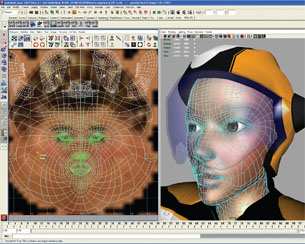 A range of new and enhanced options for manipulating and laying out u,v maps increases accuracy and productivity for this time-consuming task. |
It’s been a year since I last looked at Maya (see May 2008 DE). At first glance, not much has changed with Maya 2009; the interface looks much the same and everything’s where you expect it to be. It’s when you actually get to work that many improvements become apparent.
Selection
Oftentimes, it’s the little things that make the biggest difference, and that’s certainly true in this update. Selection is one place where Maya has really driven me nuts; it always seemed just a little too hard to select what I wanted to. Autodesk has made great strides here in Maya 2009.
For starters, there’s the new visible selection preview. As you pass your mouse over faces, edges, and vertices, they highlight on screen to show you just what you’ll be selecting if you click. I think that cut my mouse clicks by 25 percent, right there.
My favorite addition is camera-based selection. I’ve always found it needlessly tricky to select faces on the near side of an object, without also selecting the corresponding faces on the opposite side of an object—to select Antarctica without also getting the North Pole, for example. Camera-based selection allows me to do just that, selecting only what the current camera “sees.”
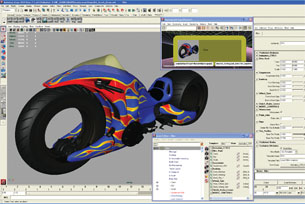 Maya Assets enable complex data to be effectively organized, shared, referenced, and presented to a variety of users in the most appropriate form. The capability to encapsulate a set of nodes into a container so that they may be treated as a single node has been dramatically expanded to include additional creation and publishing options. |
A new Tweak mode allows you to move points, edges, and faces around without manually selecting them first. Hold down the ]`] key to grab and move whatever’s under the cursor.
Soft selection allows you to make selections—and transformations—with a user-definable falloff. Previously, soft selection could only be applied to a single object but, with 2009, there is a new Global setting. You can select and modify—scale, move, rotate—components across multiple objects, simultaneously.
A number of enhancements allow you to select ranges, and loops of faces and edges more quickly and easily than before. All this really adds up: Selection is something you do quite a bit of when modeling.
Animation Layers
Maya 2009 adds animation layers to the existing render and display layers. They work in a similar way: You can turn layers on and off, singly, or in groups.
You might start with a turntable animation of a cell phone prototype. Now, create a new layer and animate the phone flipping open. Create a third layer and fly the phone in. By turning the different layers on and off, you can create animations where the phone spins and opens, or flies and spins, or all three.
You can also blend the different layers together, or fade from one to the other with a few clicks or keystrokes. The possibilities are much more exciting if you are doing complex animations with heavily articulated models, such as dancing humans or complex machinery.
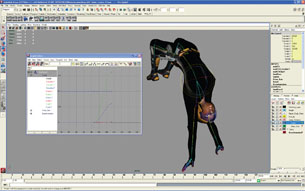 Building on technology from Autodesk MotionBuilder, the Animation Layers feature allows artists to create multiple layers of animation non-destructively. The flexible architecture works with any attribute; animation layers can be blended, merged, grouped, and re-ordered, and can override or add to preceding layers. |
Rendering
Maya’s render settings have gotten a much-needed reorganization with this latest version of the software, making it easier to navigate the growing number of options and settings.
Premiere among those new options are selectable render passes, a big work savings if you are doing high-end photorealistic work and compositing. Previously, you had to set up separate renders for each individual pass—specularity, reflections, ambient occlusion, and so forth. Now you just select which passes you want rendered from a list, and Maya will then automatically produce them for you.
Maya’s IPR (interactive photorealistic rendering) preview window now automatically responds to object and light movement as well as changes in light color and intensity, object scale, and other translations. This makes fine-tuning your lighting and modeling much quicker and easier.
If you work with 3D displays, Maya’s new stereoscopic camera is a real boon. The new camera supports anaglyph, checkerboard and horizontal interlace 3D, both in preview and in render.
Mental ray is better integrated with this version. Subdivision meshes now render directly in the mental ray without your having to apply a Poly Smooth or a mental ray Approximation node first.
Maya 2009 now also renders OpenEXR, an open High Dynamic Range format used largely in the television and motion picture industry.
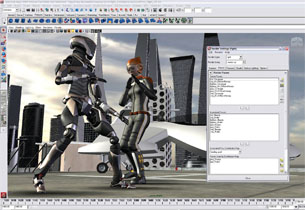 The Render Pass system for Maya has been entirely updated to provide support for production-level pipelines. Render passes enable scenes to be finely decomposed into their contributing shading elements, allowing precise control and virtually limitless iterations on the final look. |
Other Great Stuff
There’s a lot of other great stuff in this update. How valuable all of it is depends primarily on your ultimate intentions for using Maya. On the other hand, 2009’s better multiprocessor support is great for everyone.
Maya’s handling of u,v coordinates has improved considerably. Maya now preserves your u,vs as you modify meshes, so you don’t have to regenerate your u,v maps when you modify geometry. Maya’s u,v mapping tools are better in general; the new Relax tool makes it much easier to create usable u,v maps from complex shapes.
Maya Muscle is a wonderful addition for character animators, creating realistic skin deformation based on underlying muscle structures. If you design car parts, it’s probably less useful, though I’ve seen muscles used in surprising places in many mechanical designs.
Version 2009 adds a much improved particle system, nParticles, powered by Maya’s next-generation “Nucleus” dynamics simulation system, which also powers Maya’s nCloth. Muscle, nParticles, and nCloth are all available in the Unlimited version of Maya 2009.
Help
Maya’s help is comprehensive but more than a bit hard to navigate. Let’s say you’ve (ahem) forgotten where the texture editor is hiding. Searching Maya’s help will give you 400 suggested results before throwing up its hands. What you actually want is “Hypershade,” which appears 399th out of 400. Maya does provide a number of good tutorials within the help. “Assigning a Shading Material” will be in there somewhere, and will actually walk you through the steps. But if you’ve just been away from the program for a while and forgotten how to switch to camera view, it can be a real headache to find what you’re looking for.
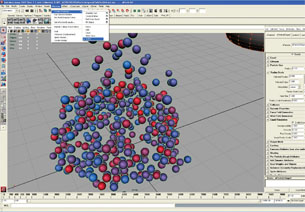 Maya nParticles is the second module built on the Maya Nucleus unified simulation framework. It can be used to simulate a wide range of effects including liquids, clouds, smoke, spray, and dust. |
To give Maya a try, you can download a 30-day trial from Autodesk.
All in all, this is a very good upgrade. Even if muscles, cloth, and stereo 3D rendering don’t excite you, Maya’s big improvements in selection modeling and rendering will dramatically speed your workflow; and that’s what it’s all about.
More Info:
Autodesk
San Rafael, CA
Maya 2009
>Price: $1,995 for Maya Complete 2009 (stand-alone) and $4,995 for Maya Unlimited 2009 (stand-alone).
>System Requirements: Available for 32- and 64-bit Microsoft Windows Vista; 32- and 64-bit Windows XP; Mac OS X 10.5.2 or higher; Red Hat Enterprise Linux 4.0 WS; and Fedora 8.
Contributing Editor Mark Clarkson, a.k.a. “the Wichita By-Lineman,” has been writing about all manner of computer stuff for years. An expert in computer animation and graphics, his newest book is “Photoshop Elements by Example.” Visit him on the web at markclarkson.com or send e-mail about this article c/o [email protected].
Subscribe to our FREE magazine, FREE email newsletters or both!
Latest News
About the Author
Mark ClarksonContributing Editor Mark Clarkson is Digital Engineering’s expert in visualization, computer animation, and graphics. His newest book is Photoshop Elements by Example. Visit him on the web at MarkClarkson.com or send e-mail about this article to [email protected].
Follow DE





